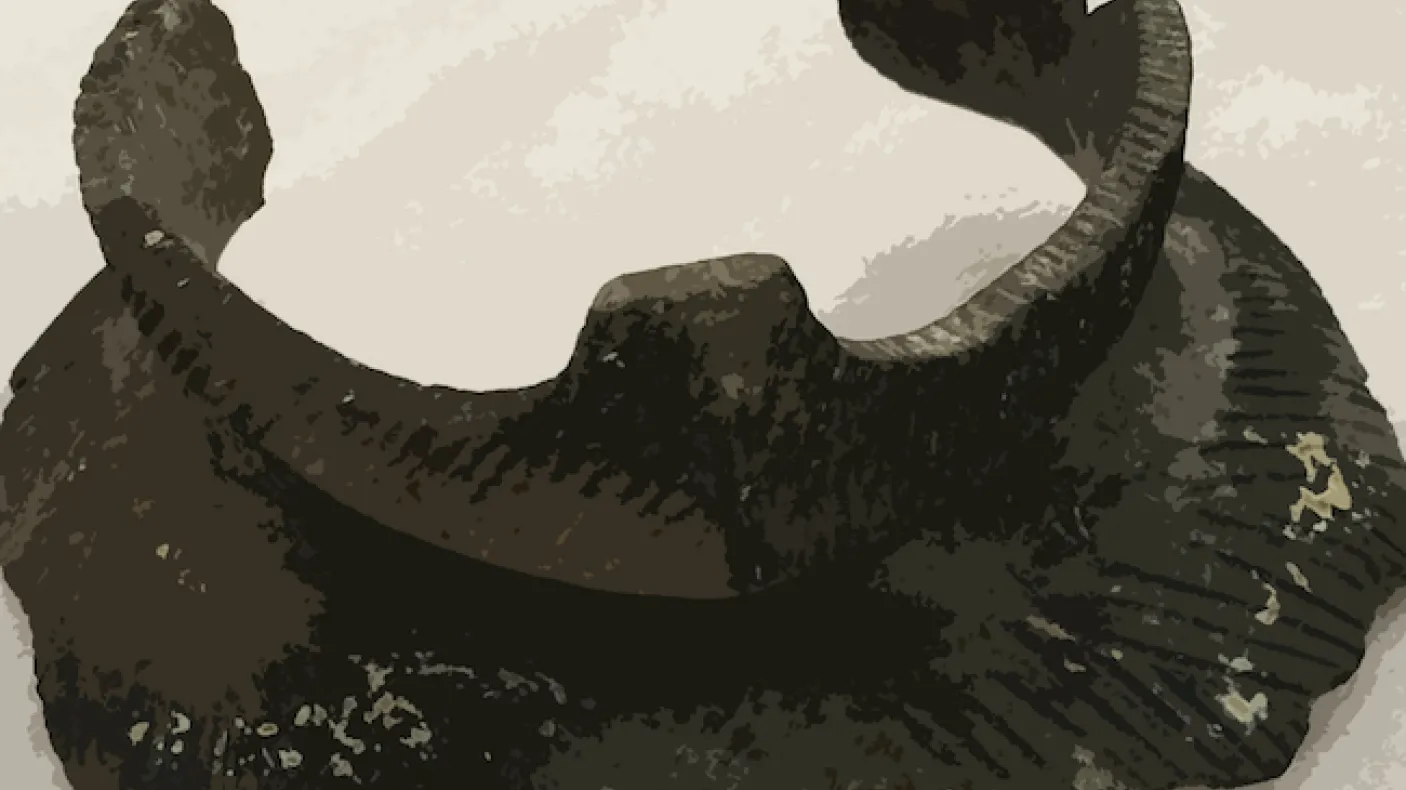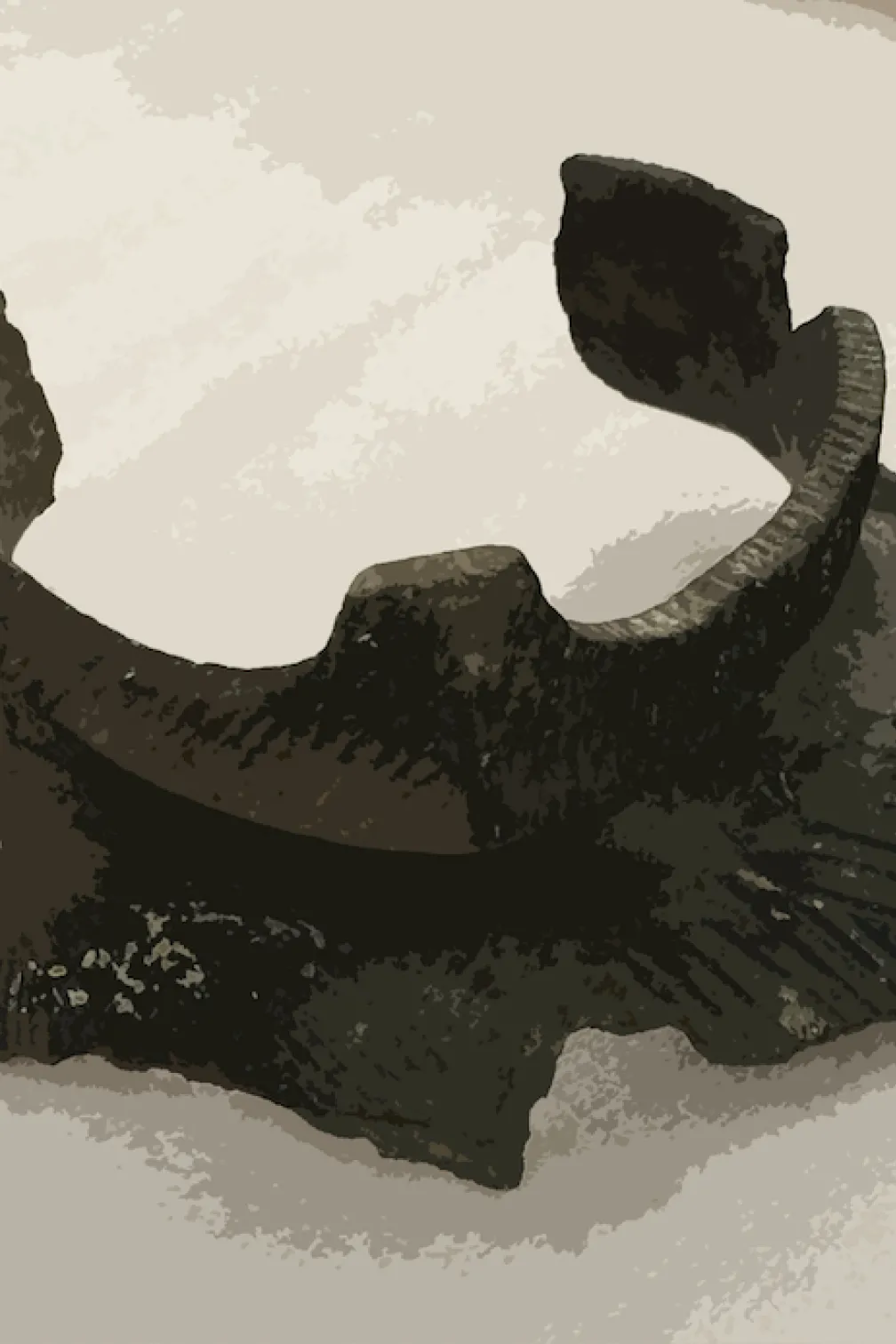Wyandot Approaches to Archaeological Ceramics
Published
Categories
Author
Blog Post
Wyandot Approaches to Archaeological Ceramics
By Richard Zane Smith and Catherine Tammaro
This blog entry is the third in a series dedicated to Remembering Ancient Ceramic Traditions, a project initiated by us when we visited the Royal Ontario Museum’s New World Archaeology Collections to view and handle pottery made by our Ancestors. You can read more on the general idea behind the project in our first post and learn about typical archaeological approaches to ceramics in our second post. In this entry, we discuss and explore our specific orientations—that is, as Wyandot artists—to the archaeological ceramic collections.

Photo by Richard Zane Smith
What is it about pottery sherds? Aren't they just pieces of discarded broken crockery?
For us, the answer is a resounding no. Our visit to the ROM’s inner sanctum was intriguing! When we visit such places, we go to learn about all aspects of our Ancestral culture through making works using ancient—and some modern—methods, even if these techniques are not incorporated into contemporary works. Studying shapes and forms lends itself to knowledge about our Ancestors from a cultural, spiritual, and experiential standpoint; it is deeply satisfying as it fills in gaps in awareness.
Motivations and Questions
Richard: As one who has continually worked with clay for over 30 years, and involved in revitalization of indigenous pottery traditions, my hands and eyes go over the broken pieces, turning them this way and that, and then something registers, a recognition, an 'aha!' moment of vision and discovery. To look carefully at cross sections and to see, captured in time, stretch marks; soft clay once pulled and coaxed along, the presence of finger marks, smears, the gritty temper, my mind rushes to fill in blanks and unravel questions, to connect, to feel the preserved presence of my Ancestors’ hand movements and here they are, now in my hands. They watched these same surfaces that I now watch, reading marks like tracks in a muddy creek bottom, as fresh as yesterday’s robin tracks.
Catherine: My particular areas of interest in ancient Wendat pottery regard learning whether ceremonial vessels are distinguishable from others commonly used as domestic ware. I seek to discover theories and information on how pottery traditions were passed down between generations. Can we find evidence of mother-to-daughter transmission of patterns and forms? Can we find discrete designs related to this at specific archaeological sites? Will these tell us about kinship groups or clans? I am particularly interested in how women potters might have moved from location to location over time. Can we use the ceramics to trace their movement? Were ancient vessels somehow a reflection of the understanding of the ‘life authority’ or life controllers, as each vessel contained some aspect of those primal relationships between sustenance, survival, and the sacred. Clan and clay after all, have the same root stem in Wendat; what ways might these sacred relationships have been articulated in the making of pottery?
The origins of decorative patterns and pottery forms also intrigue me. What were ancient potters’ inspirations for them? Did our Ancestors refer to astronomical notions in their shape and pattern choices? What memories, maps of the cosmos, creation stories, ceremonial paradigms, or directional ideologies might have been included in the making of vessels? Alternatively, perhaps they were simply all about function? What ceremonial intention may have been imbued in these sacred pieces?
Drawing Connections
Catherine: When asking questions about our Ancestor’s pottery, it seems almost as if something is already known without being learned, some answer is given, even sometimes without questions being fully formulated. When viewing and handling pottery in the ROM’s collections, I recall drawing similar patterns as those seen on Iroquoian vessels all through my childhood and in my adult art practice. Remarkably, my early pots—made long before I saw my Ancestor’s pots in books or museums—resembled those Ancestral forms. I’ve always found this interesting. I wonder about what Ancestral memories are contained in my DNA.
Richard: The pottery of our Ancestors has many lessons to teach.

Photo by Richard Zane Smith
Cross-sections like the one above reveal building secrets and speak of coil breaks, of stretched slabs, and of how rims were thickened for stability and endurance. That which was once fluid, living and soft, has been preserved by fire like fossil dinosaur bone, revealing a history of actions, like tree rings.

Photo by Richard Zane Smith
The above cross section shows where a coil was added and welded into the bottom half of the vessel and at the neck as well. The thinness of the base suggests it was paddled over the form of an over turned older pot and allowed to stiffen before the first coil was added. Because the added clay was softer than the base, it left a noticeable thick spot where soft clay joined the harder clay.

Photo by Richard Zane Smith
The above cross section reveals an added coil on the shoulder of this pot.

Photo by Richard Zane Smith
Above, the parallel hatched lines and triangular and diamond like patterns seem to repeat over and over on these forms. These were likely made with a bone awl or bone hairpin by dragging the edge of the tool over the vessel, not by incising with the point. Pots of this general form seem to be more typical of Tionontate People (Tobacco Nation), who in the mid-1600s merged with groups of the Wendat fleeing westward.
Final Thoughts

Photo by Richard Zane Smith
Richard: With the above example, lines wander freely. There is pattern, oh yes, for sure but without rigidity and drive to get every line perfect. Instead I see a calm acceptance of the ‘flaw’ as a part of life, of every day, and every season, of joy and sorrow... I get the message and am humbled…
The handling of these pieces puts me at ease. It’s like being in the presence of a group of Elder women sitting together, laughing and gossiping. There are masterful Wendat pottery works represented in the ROM's collection, but so many of these vessels were made by average villagers who simply made ALL their own things, they had their own village and nation ways and girls learned by watching those family members who set before them, month after month. The techniques, the shapes, the design work, all created within a safe village site. There is a noticeable feel of being casual with the materials, a sense of calm...nothing extreme...just the daily life of basic living; of collecting water, of cooking of sitting and eating with family and other villagers. These are what these sherds tell me as I hold them in my hands.
Catherine: Although I was unable to answer the questions discussed above during my visit, I am left with the overwhelming certainty that somehow and in some way, the vessels are a reflection of the natural environment, viewed through an Ancestral paradigm. Vessels hold sacred water, sustenance, nourishment; they support survival and as other art forms, including effigy pipes, garments, the construction and placement of longhouses. All of these things seem to reflect a specific world-view, so perhaps pots and vessels do too. Perhaps the vessel is the cosmic vault itself; the spherical shape a reference to the heavens, the designs, reflections of patterns found in nature, or references to the structure of a longhouse-like container.
All these questions are deeply embedded—in some way—in my own creative psyche, as an art maker. I do feel a deep cultural connection to the works I’ve seen. I know that studying—and I hope that somehow making—such vessels will help to answer some of the questions that I have. The partial forms and vessels at the ROM are magnificently designed and made, and the experience was incredibly enriching and exciting. It will certainly stimulate more exploration, research and art making!
Look for our final blog post in the coming months; in it, we bring our views into closer dialogue with that of the ROM’s curator of North American Archaeology, Craig Cipolla.


